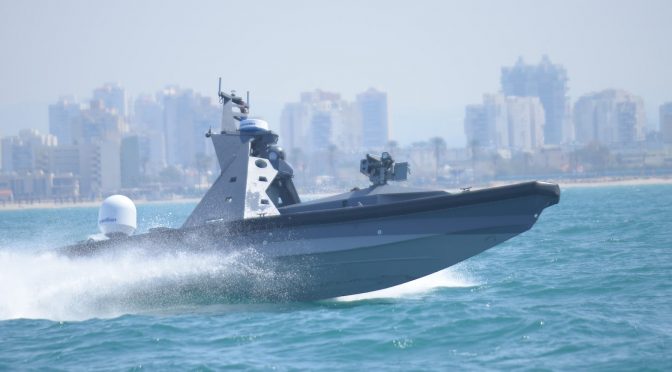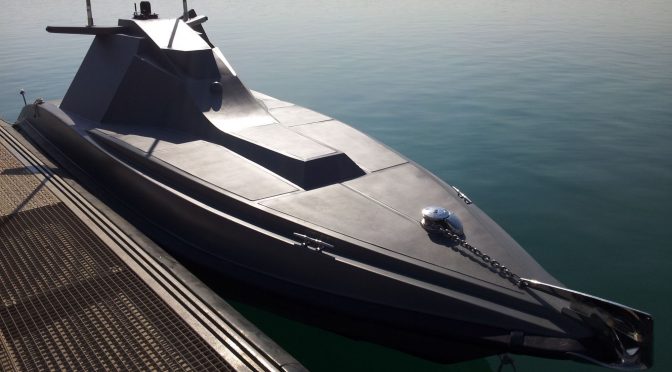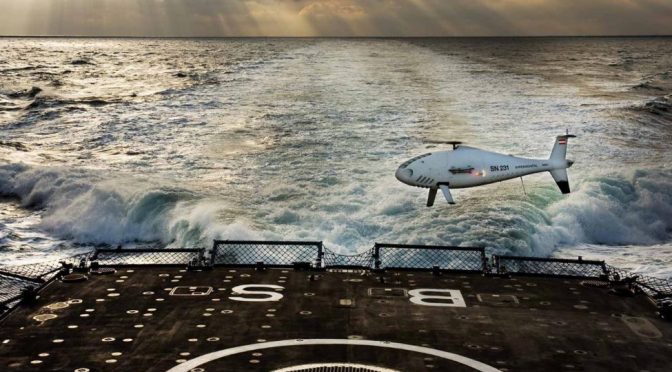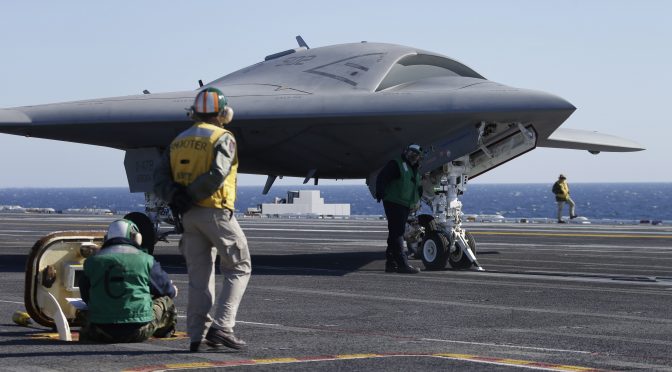The following is an entry for the CIMSEC & Atlantic Council Fiction Contest on Autonomy and Future War. Winners will be announced 7 November.
By Mike Barretta
USS Truk Lagoon, LSD-63
South China Sea
She was petite, only five foot three, even in boots.
“Just tilt your head forward a bit, Howie. You know I’m short. I can’t see the jack,” said Corporal Wilhemina Hicks.
The Humaniform Assault Unit disengaged itself from its niche and tilted its head forward.
“I’m sorry. I forgot,” said the robot.
“That’s okay,” said Wihemina. She knew the robot didn’t forget. It couldn’t. The machine selected from a range of responses to simulate human interactions. Sometimes she found its simulations charming, sometimes annoying, as if it was a real person. She still couldn’t see the jack, but she never could.
“Take a knee.”
With the ritual complete, the machine complied, dropping to one knee so she could pop the rubber plug and insert her tablet’s cord into the maintenance jack where a human would have a right ear.
“Better?” asked the machine.
“Better,” she agreed. The machine was four years old, old enough to acquire a spooky faculty with natural human language through its learning routines. She didn’t think it understood what she was saying, but simply responding to pleasantries as if they were commands. Some of the autonomous machine captains heaped verbal abuse upon their equipment, but it wasn’t in her nature. She treated Howie as a person. She didn’t think it odd at all. Lonely old folk spoke to their pets. Children extended their imaginations to imbue their toys with impossible qualities. She was a U.S. Marine speaking to a 300 pound killing machine.
“Range of motion exercises, please Howie”
She backed up and the machine stepped forward to give itself space to move. The power cord stretched and the machine reached behind without looking and disconnected itself. That simple act of proprioception, an action that could be performed completely without consciousness by a human being was a miracle of machine coding. Exposed status lights showed the switch from ship’s power to internal battery power. Howie went through his routine to demonstrate that all its joints were fully functioning. When it was done, she checked its joints with a thermal imager to ensure heat buildup was within tolerances. She signed off the maintenance action form on her tablet.
“Are you feeling good?”
“Yes, I am,” said Howie.
The designers could just as easily have programmed the machine to say, “Mobility and Kinetics are within tolerances.” At one time, the machine probably did speak like that, but with experience, it had adapted its responses to the way she spoke. The facsimile of conversation was so natural it might as well be an actual conversation. She had had less productive talks with her mother, who still couldn’t believe that her only daughter had joined the U.S. Marine Corp.
“A” school warned her about anthropomorphizing the hardware. As far as she was concerned, If they didn’t want her to anthropomorphize the machine, they shouldn’t have made it in a shape of a person. The logic for a human-based planform was sound. Two manipulative appendages, two locomotive appendages, and a sensory stalk mounted high meant Howie could go anywhere and do anything a human could. Except swim. The machine could definitely not swim.
She accessed the neurologics display. Howie was a captain, the highest categorization for autonomous machines. The designation was a composite score based upon successful decision making in the prosecution of assigned missions and evolved neurologic complexity. When constructed, it was designated a rifleman, slaved to a human operator or another captain. Howie progressed through sergeant, a machine capable of semi-autonomous action, to Captain, indicating it was capable of undirected independent action in hostile environments.
The machine’s neurologic core was composed of six billion auto-programmable logic gates electron etched onto a silver-palladium wafer. Forty-two of these wafers were laminated together to form the core and installed in the unit’s brain housing group. Once turned on, experience modified the logic gates such that each machine could be distinguished by the patterns built up in their processors. Howie learned, and his experiences distinguished him from other machines of its kind. Though it did not have quite the number of connections in a human brain, Anthrodynamics, the machine’s manufacturer found a biological model to mimic.
Howie operated like a jumping spider, a fearsome little predator, that utilized a brain emulation strategy to perform complex behaviors thought to be impossible by a creature with relatively few neural connections. Howie sliced up an event into discreet moments no longer than a picosecond and calculated a strategy for success to reach the next picosecond. It performed these calculations so fast that even the most kinetic environments stood frozen in time from its perspective. Howie flowed seamlessly from one moment to the next.
She should have been afraid of it, at least the part about spiders, but she wasn’t. Around her, Howie was careful.
Wilhemina noted the complexity index of Howie’s neural architecture, though stable, it rested at the upper limit for learning machines of his class. Beyond this threshold, neurologic performance, degraded. AI Engineers did not know why, but they theorized that beyond this point, complexity stepped beyond what the architecture could reliably support.
“You’re good Howie,” said Wilhemina.
“Thank you,” said Howie.
“I have some news. I haven’t told anyone yet. Do you want me to tell you?”
“Yes, I would.”
“I’m pregnant.”
“Underway is a hazardous environment for a pregnant woman. They will put you ashore. I will miss you.”
“That’s why you can’t tell anyone. I shouldn’t have gotten pregnant. I know this. I give myself good advice, but I seldom follow it.” She took the robots hand and guided it to her belly. It’s here inside me. Can you feel it?” The machine was kind and patient to her in a way that was indistinguishable from real kindness and real patience so she thought, what’s the difference?
The machine’s hand was warm.
“I feel it,” said the machine. It removed its hand.
“Are you happy for me?”
“I am happy for you.”
She had no idea if the machine felt happy for her or not, but she was prone to believe in impossible things, like true love and happily ever after. Her work with the Howie was done. It didn’t really need too much in the way of maintenance unless they were combat damaged. “Howie, would you like me to read to you again.”
“Yes, I would,” said Howie. The machine had access to the ship’s Watson and could access nearly anything that it desired. The problem was it did not desire. It accessed what others thought it needed to perform its mission. Howie moved with supernatural machine grace that belied the speed and strength of its frame, and though it was completely unnecessary for it to do so, sat down. The metal chair creaked under its three hundred pound weight. She pulled a book from behind the slot for the machine’s hardcopy log books and operations manual.
She opened Alice in Wonderland to a book marked page. “I’ll read this to my baby,” said Wilhemina.
She read. “I wonder if I’ve been changed in the night. Let me think. Was I the same when I got up this morning? I almost think I can remember feeling a little different. But, if I am not the same, the nest question is ‘Who in the world am I?’ Ah, that’s the great puzzle…”
She lowered the book and looked at Howie. “This could be about you couldn’t it?”
“Yes, I think it is,” said Howie.
“What kind of rabbit hole did you fall down to wind up here?” asked Wilhemina.
“The same one you did, I imagine.”
Autonomous Motor Vessel Pacific Conveyor
South China Sea
The Autonomous Motor Vessel Pacific Conveyor , a Group three, containerized, Panamax freighter modified for autonomous operations, blasted the small boats with its water cannon. The boats curled away from their approach and stood off for a moment. One of the cannons drizzled water and the boats darted in, tossing in the wake. They made their way to the area beneath the drizzling cannon. A makeshift ladder was extended and levered up to latch on to the railing. Boarders slung with AK-47’s and backpacks clambered aboard.
“Do they know we are here?” asked one of the boarders.
“Drone!” shouted another. He pointed his AK at the horizon.
“They know. It’s okay,” said Miguel. “They are just coming in to take a peek and intimidate us a bit.”
The man lowered his weapon. The MQ-4C Triton overflew the ship at fifty feet and banked away, climbing back to altitude. Tritons rarely came below 35,000 feet unless they were landing or attacking. The U.S. Navy would not fire upon them, but Miguel Fuentes, the leader of this band was relieved to note that the hard points under the wings were empty. The Triton could carry Hellfire and Harpoon, but most of the time it just harassed the Chinese man-made islands and kept tabs on their type 55 destroyers.
“We have to move fast and get into the bridge.” Miguel leaned over and helped the last of the boarders over the rail. The two speedboats peeled off back to their mothership.
“I hope your software works.”
“It’s the same interface a pilot would use,” said Miguel. “It will work.”
They climbed the external superstructure ladders to the bridge level. Mounted cameras panned, tracking their movements. Right now, someone in the line’s operations center was assessing the situation and determining a course of action. Obviously, they had already reported the piracy incident to the U.S. Navy.
“You two, topside,” said Miguel. “Find the downlink antenna and cut the link cabling. Keep voice.”
The men nodded and continued their climb. The water cannons cut out. Miguel reached into the backpack of one of his men and pulled out a five foot length of det cord. He taped the cord to one of the bridge’s windows and inserted cabled detonator.
They retreated to the backside of the superstructure trailing wire.
“Fire in the hole.”
He pushed a button and the cord popped shattering the window. Armor the door all you want, he thought, but people needed windows. The ship’s autonomous software was good enough to bring the ship pier side without scratching the paint, but most ports and unions insisted on a pilot.
They clambered in and over a console and spread out across the bridge inspecting it carefully. It was illegal to set mantraps, but it was known to happen.
“This is Mark Grimes. I am the incident coordinator for American Lines. What do you want?” said a voice from an overhead speaker.
“Mr. Grimes. Don’t be stupid,” said Miguel. “We want your manifest. There are people who are dying for these supplies.”
“This ship’s supplies are going to a disaster zone.”
“It’s not going to my disaster zone. The Chinese can afford more.”
“I am authorized to negotiate a ransom.”
“I need your cargo,” said Miguel. “If you want to give me money, I’ll accept that too.” He plugged his laptop into the ship’s control interface. The ship’s response to unauthorized access would be to launch electronic intrusion counter-measures, but his codes were valid. The ship’s consoles lit up.
The two he sent to the roof crawled in through the window. “Downlink is secured, voice only. They can talk to us, but they can’t take the ship back.”
“Good job.”
He tapped his screen to designate a waypoint and the ship turned. The men cheered.
“You are Miguel Fuentes, former disaster relief director for the International Red Cross,” said Mark Grimes.
“I am Miguel Fuentes,” said Miguel. “I am going to go relieve a disaster that the international community has ignored.”
“You are probably going to Luzon. We will notify the Philippine’s government of your intent.”
“Turn that speaker down,” said Miguel.
One of his men reached up and turned the volume to off.
The shipping line’s protests would fall on deaf ears as would any from the U.S. government. He had control of 43,000 tons of humanitarian relief supplies and he was giving it people that desperately needed it. The Conveyor was a rare U.S. flagged ship and the Philippines had been slowly drifting away from U.S. influence.
Combined Maritime Operations Center
Pearl Harbor, Hawaii
“Seats please,” said Admiral Lewis. Commander, U.S . Pacific Fleet. “What am I looking at?” His staff stood at attention around him and sat down with him as he took his own.
The briefer, post-command Commander, gestured and the lights dimmed. “Sir, this is the American flagged Autonomous Motor Vessel Pacific Conveyor. There is no crew aboard. The ship is a Group three, Panamax converted for autonomous operations. It was bound for China when it was boarded and its systems were co-opted by one identified subject, Miguel Fuentes, and five unknown subjects. Fuentes is Pilipino-American, enlisted in the U.S. Navy, honorably discharged, earned his degree at Clemson, and worked as disaster relief coordinator for the International Red Cross. This is him doing a CNN interview decrying the state of International aid to the Philippines after super typhoon Nangka last year.
“We assume that he has knowledge of our operations?”
“Yes sir, He was an operations specialist first class, so he was on the execution end of things and not necessarily planning.”
“The boy has done well. He doesn’t sound like a profit motivated kind of guy.”
“No sir, our intelligence suggests he is taking the ship to Luzon to off-load its cargo of disaster relief supplies. The Conveyor is carrying containerized food supplies, medicines, desalinization and power generation equipment.”
“Appropriate,” said the Admiral.
The Philippines hadn’t recovered from Nangka, when Lupit, a strong tropical storm, and Talam, another super typhoon, scoured Luzon to mud. Cholera raged in the post- storm environment.
To be fair, Luzon had received a steady stream of aid, much of it from the United States, but it was never enough and it competed with storms that had hit the United States Atlantic and Gulf Coasts.
“We should just let him keep it. Insurance will pay for the cargo and the ship and the Chinese will buy more, but we are here to make an example for all the other pirates. I am inclined to take him at his word that he is going to do good works. That makes this all the sadder,” said the Admiral.
The image of the ship spiraled, rotating around its center. “I can keep the Triton on station for another two hours,” said the Commander.
“Colonel.” said the Admiral Lewis. “You’re up.”
“The USS Truk Lagoon, a Flight IIA LSD has an engineering casualty. They have detached from the ESG and are trailing shaft to Hawaii for repairs, but they are within V-22 range. The ships are opening each other, but we still have opportunity to respond. We can put a Humaniform Assault Unit on board, take back the ship, and redirect it. The Ford Carrier Strike Group can recover the units. Zero exposure for Blue force or collateral casualties. The only humans involved are red. The situation seems tailor made for HAU assault. This is a picture of the actual unit that will participate in the assault. It is designated Captain and has an outstanding record.
“Zoom in. What’s that on the machine’s glacis plate?”
The Colonel zoomed in.
“What the hell is that?” asked the Admiral.
“It’s a Hello Kitty, sir. My daughter…”
“I know what Hello Kitty is.”
“It’s holding an AR-100, sir.”
“Nothing more terrifying than a Hello Kitty with an assault rifle. In my day we had shark teeth.”
“It’s a different world ,sir.”
#
Autonomous Motor Vessel Pacific Conveyor
South China Sea
As the smallest of the U.S. military forces, the Marine Corp was always looking for methods to leverage their effectiveness. This philosophy led to the V-22 Osprey, the F-35B Lightning II, and the AR-100 assault rifle. Each system they procured had difficult births, but evolved into excellent weapon systems. The Marines anticipated the Humaniform Assault Units would follow the same trajectory.
Howie rappelled out of the back of the V-22, sliding down a line that placed it between the six story tall stack of containers to the deck of the ship. It took cover and trained its weapon back towards the ship’s bridge. The remainder of its unit followed. The V-22 departed having pressed the limits of its range.
Howie directed the advance. The machines used the available cover of the stack of containers and deck equipment. They moved quickly and efficiently. At the base of the bridge superstructure, Howie split its unit to cover both external entrances. Three went to cover the starboard side and it and one other took port. The only other way out of the bridge was through a magnetically locked armored door that protected the way to engineering. The assessment was that the pirates did not carry sufficient explosive power to breech any of the armored doors to gain access to the interior.
Howie reached the bridge level. Its other units reported in position. It observed the shattered window, approached and listened.
“Miguel what are we going to do. Those machines!”
“I don’t know. Let me think.”
“Can we kill them?”
“No, we can’t. We might be able to damage one as it comes through the window with massed fire, but that is it. I didn’t know they had these things so close. I didn’t plan for it.”
Howie stepped into sight. It held his weapon in view but did not train it on the men.
“You are Miguel Fuentes,” said Howie.
Howie saw that the man was terrified. Convention dictated that terror was a desired end state, but in its experience, fear made human responses even more unpredictable.
“Who am I talking to?” asked MIguel
“You are talking to me. I am a Humaniform Assault Unit, ordered to compel your surrender and take control of this vessel.”
“I can’t surrender.”
The man stiffened and Howie estimated that it was the behavior of a man resolved to his purpose. There would be violence here.
“Under what conditions will you surrender?”
“There are children dying in Luzon. They are dying of starvation and exposure and cholera. You wouldn’t know about those things would you?
“I know of these things, but I am not vulnerable to them.”
“Vulnerability is part of the human condition. I will surrender when the children of Luzon are safe. Do you know what is happening there? Ah you can’t. It’s impossible for you, a machine, to understand what I am doing.”
But Howie did. It had been fed a steady diet of human suffering since it came on line. Suffering was deemed tactically significant as a cause of violence. Violence stimulated evolution of Howie’s auto-programmable logic gates.
“Why, sometimes I’ve believed as many as six impossible things before breakfast,” said Howie. Howie felt funny as if his inputs were skewed. He self-assessed. Neurologic complexity spiked off the scale as the logic gates reprogrammed to a new configuration. “You may proceed to Luzon.”
“Why would you do this?” asked Miguel.
“I’m afraid I can’t explain myself, sir. Because I am not myself, you see?” said Howie. “Proceed to Luzon.”
“How can I trust you?”
“Trust,” said Howie. “If you’ll believe in me, I’ll believe in you. Is that a bargain?”
Combined Maritime Operations Center
Pearl Harbor, Hawaii
“We are analyzing the downloads of the machine’s neurologic activity.” said the technical representative from Anthrodynamics. “This information is unprocessed and shows just raw information. This time index shows where the machine breaches the complexity threshold. We will know better when we recover it.”
“Commander?”
“Recovering the machines is not going to be a problem. The Philippines is cooperating since we gifted them the relief supplies.”
“Yes, that’s a polite way of putting it,” said Admiral Lewis.
“Admiral, I am not a believer in emergent states,” said a Navy Captain.
“I am not interested in what you believe in Captain.”
“I don’t think…”
“Then you shouldn’t talk,” said Admiral Lewis. “Unless you have evidence to support your assertion. He turned away. “Carry on,” he said to the techrep.
“It is policy to decommission the neurologic processor before this threshold. It should have had at least three years of useful life before it crossed the redline. One of our problems is that we have no theory that accounts for rate of change in the processor. This one seemed to have abruptly gone exponential.”
“How puzzling all these changes are,” said Admiral Lewis. “If we can’t be sure what these machines are going to be, from one minute to another, how can we utilize them in a combat environment?”
“Yes sir, that is the question. They would be no better than people,” said the Tech Rep.
“Curiouser and curiouser,” said Admiral Lewis.
End
Mike Barretta is a retired naval aviator who works for a major defense contractor. He holds a Masters degree from the Naval Postgraduate School in Strategic Planning and International Negotiations and a Masters degree in English (creative writing) from the University of West Florida. His stories have appeared in Apex, Redstone, New Scientist, Orson Scott Card’s Intergalactic Medicine Show, and various anthologies including the Young Explorer’s Adventure Guide, War Stories, and The Year’s Best Military Sci-fi and Space Opera.
Featured Image: Rafael unmanned surface veicle (Rafael)




